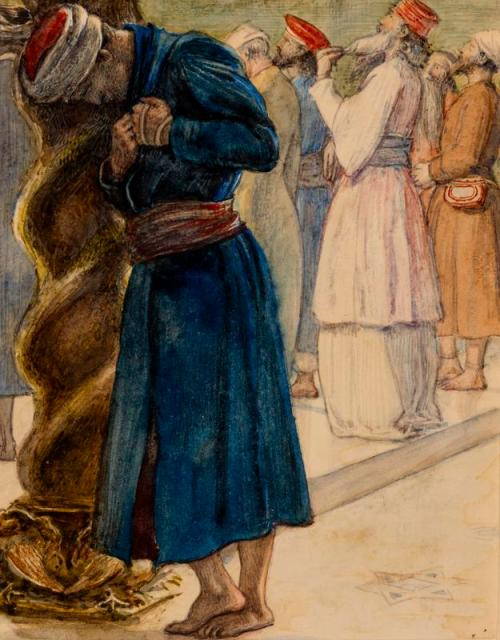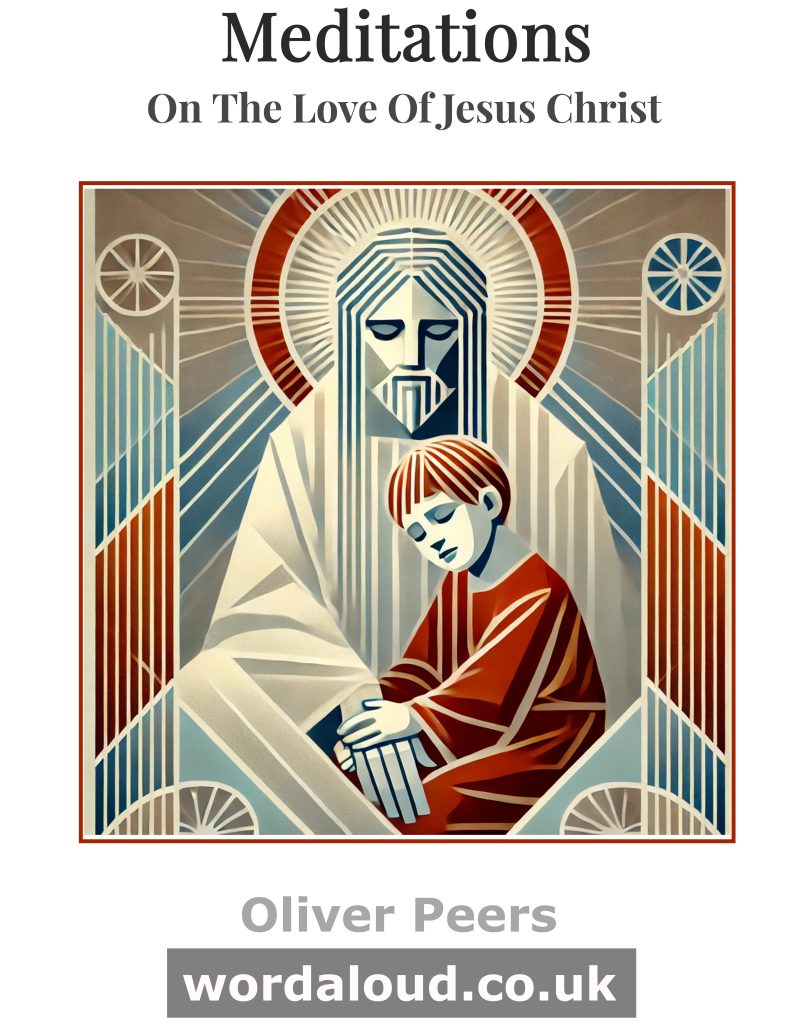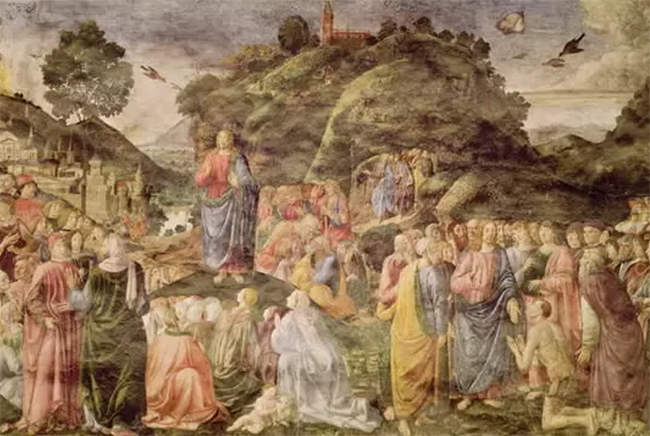Christian Art | Scribes And Pharisees – Hypocrites
The Gospel Of Saint Matthew 23: 13-39 | King James Audio Bible
Who Were The Scribes And Pharisees In The Gospels?
The scribes and Pharisees were two groups of religious leaders in ancient Judea, during the time of Jesus. The scribes were scholars who were responsible for copying and interpreting the Hebrew Scriptures (also known as the Old Testament). They were experts in the law and were often consulted on matters of religious practice and doctrine.
The Pharisees were a Jewish sect that focused on strict adherence to the commandments and laws found in the Hebrew Scriptures. They believed in the resurrection of the dead, the existence of angels and demons, and the coming of a Messiah.
Both the scribes and Pharisees were influential in Jewish society and held positions of authority. In the Gospels, they are often depicted as being opposed to Jesus and his teachings. They are portrayed as being concerned with maintaining their own power and status, rather than being truly interested in spiritual matters. They are also depicted as being hypocritical and judgmental, and as trying to trap Jesus with clever questions.
Despite their opposition to Jesus, the Gospels also contain instances where Jesus engages with the scribes and Pharisees in respectful and productive dialogue. In some cases, Jesus even commends them for their knowledge of the law and their dedication to their faith. However, overall, the Gospels depict the scribes and Pharisees as being opposed to Jesus and his teachings, and as being more concerned with maintaining their own power and status than with truly following God’s will.
Give Examples
Here are examples from the Gospels of how the scribes and Pharisees are depicted:
- In the Gospel of Matthew, the scribes and Pharisees criticize Jesus for allowing his disciples to pluck grain from a field on the Sabbath, arguing that it violates their interpretation of the Sabbath law. Jesus responds by pointing out that the law also allows for acts of mercy and compassion on the Sabbath, and that he and his disciples are not breaking the Sabbath law. (Matthew 12: 1-8)
- In the Gospel of Mark, the Pharisees criticize Jesus for healing a man on the Sabbath, again arguing that it violates their interpretation of the Sabbath law. Jesus responds by pointing out that the law allows for acts of mercy and compassion on the Sabbath, and that he has the authority to heal and do good on the Sabbath. (Mark 3: 1-6)
- In the Gospel of Luke, the Pharisees criticize Jesus for eating with sinners and tax collectors, arguing that he should not associate with such people. Jesus responds by pointing out that it is the sick who need a doctor, and that he has come to call sinners to repentance. (Luke 5: 27-32)
After this, Jesus went out and saw a tax collector by the name of Levi sitting at his tax booth. ‘Follow me,’ Jesus said to him, and Levi got up, left everything and followed him. Then Levi held a great banquet for Jesus at his house, and a large crowd of tax collectors and others were eating with them. But the Pharisees and the teachers of the law who belonged to their sect complained to his disciples, ‘Why do you eat and drink with tax collectors and sinners?’ Jesus answered them, ‘It is not the healthy who need a doctor, but the sick.’
- In the Gospel of John, the scribes and Pharisees criticize Jesus for claiming to be the Son of God and for performing miracles, arguing that he is blasphemy and that he is using the power of Satan to perform his miracles. Jesus responds by pointing out that he has the power to perform miracles because he is the Son of God, and that his miracles are signs that he has been sent by God.
The Gospels depict the scribes and Pharisees as being opposed to Jesus and his teachings, and as being more concerned with maintaining their own power and status than with truly following God’s will. They are depicted as being hypocritical and judgmental, and as trying to trap Jesus with clever questions. Despite this, the Gospels also contain instances where Jesus engages with the scribes and Pharisees in respectful and productive dialogue, and in some cases even commends them for their knowledge of the law and their dedication to their faith.
Who Were The Sadducees?
The Sadducees were another group of religious leaders in ancient Judea, during the time of Jesus. They were a Jewish sect that held a more liberal interpretation of the Hebrew Scriptures than the Pharisees. They rejected the Pharisees’ belief in the resurrection of the dead, angels, and demons, and they focused more on the practical application of the commandments and laws found in the Hebrew Scriptures.
The Sadducees were a wealthy and influential group, and they held positions of power within the Jewish community. They were often in conflict with the Pharisees, and they are depicted as being opposed to Jesus and his teachings in the Gospels.
In the Gospels, the Sadducees are often depicted as trying to trap Jesus with difficult or trick questions. For example, in the Gospel of Matthew, the Sadducees ask Jesus about the resurrection of the dead, hoping to catch him in a contradiction. Jesus responds by pointing out that the Sadducees’ understanding of the resurrection is limited and that they do not understand the power of God.
Matthew 22:23-33: That same day the Sadducees, who say there is no resurrection, came to him with a question. ‘Teacher,’ they said, ‘Moses told us that if a man dies without having children, his brother must marry the widow and have children for him. Now there were seven brothers among us. The first one married and died, and since he had no children, he left his wife to his brother. The same thing happened to the second and third brother, right on down to the seventh. Finally, the woman died. Now then, at the resurrection, whose wife will she be of the seven, since all of them were married to her?’ Jesus replied, ‘You are in error because you do not know the Scriptures or the power of God. At the resurrection people will neither marry nor be given in marriage; they will be like the angels in heaven. But about the resurrection of the dead—have you not read what God said to you, “I am the God of Abraham, the God of Isaac, and the God of Jacob”? He is not the God of the dead but of the living.’
The Gospels depict the Sadducees as being opposed to Jesus and his teachings, and as being more concerned with maintaining their own power and status than with truly following God’s will. They are depicted as being skeptical of Jesus and as trying to trap him with difficult or trick questions.
Describe Temple Judaism In The Time Of Jesus
Temple Judaism, also known as Second Temple Judaism, refers to the form of Judaism that was practiced in the land of Judea during the time of Jesus. The Temple in Jerusalem, which was the centre of Jewish worship and sacrifice, played a central role in Temple Judaism.
During this time, the Hebrew Scriptures (also known as the Old Testament) were considered to be the authoritative word of God, and the laws and commandments found in the Hebrew Scriptures were central to Jewish religious practice. The oral traditions and interpretations of these laws and commandments, as well as the practices and rituals associated with the Temple, were also important elements of Temple Judaism.
The Temple was the centre of Jewish worship and sacrifice, and it played a central role in Temple Judaism. The Temple was the only place where certain sacrifices and rituals could be performed, and it was the place where the presence of God was believed to reside. The priests, who were responsible for performing the Temple sacrifices and rituals, were a powerful and influential group within Jewish society.
In addition to the Temple and its associated sacrifices and rituals, Temple Judaism also included a number of other practices and beliefs. For example, the Pharisees, who were a Jewish sect that focused on strict adherence to the commandments and laws found in the Hebrew Scriptures, played a significant role in Temple Judaism. They believed in the resurrection of the dead, the existence of angels and demons, and the coming of a Messiah.
The Sadducees, another Jewish sect, held a more liberal interpretation of the Hebrew Scriptures and rejected the Pharisees’ belief in the resurrection of the dead, angels, and demons. They focused more on the practical application of the commandments and laws found in the Hebrew Scriptures.
Temple Judaism was a complex and diverse religious tradition that was centred around the Temple in Jerusalem and the Hebrew Scriptures. It included a variety of practices, beliefs, and understandings, and it was shaped by the various sects and groups that were active in Judea during the time of Jesus.
Who Were The Priests?
In the context of Temple Judaism, the priests were a group of religious leaders who were responsible for performing the sacrifices and rituals associated with the Temple in Jerusalem. They were a powerful and influential group within Jewish society and held positions of authority within the Temple.
The priests were divided into two main categories: the high priests and the regular priests. The high priests were the chief leaders of the priestly order and were responsible for overseeing the Temple and its activities. They were also responsible for performing certain special sacrifices and rituals, such as the annual Day of Atonement sacrifice.
The regular priests were responsible for performing the other sacrifices and rituals that were carried out in the Temple. They were also responsible for the maintenance and upkeep of the Temple and its facilities.
In the Gospels, the priests are depicted as being opposed to Jesus and his teachings. They are depicted as being more concerned with maintaining their own power and status than with truly following God’s will. In the Gospel of John, the priests are depicted as being involved in the plot to have Jesus arrested and crucified. However, there are also instances in the Gospels where the priests are depicted as being respectful and willing to engage in dialogue with Jesus.
Discuss The Impact Of AD 70 On The Construction Of The Gospels
The destruction of the Temple in Jerusalem in AD 70 was a significant event in the history of Judaism and the early Christian community. The Temple, which was the centre of Jewish worship and sacrifice, played a central role in Jewish religious practice and was a symbol of the presence of God among the people.
The destruction of the Temple in AD 70 had a number of impacts on the construction of the Gospels. One impact was that it likely contributed to the shift in focus from the Temple and its associated sacrifices and rituals to the person and teachings of Jesus. With the destruction of the Temple, the traditional practices of Temple Judaism were no longer possible, and the early Christian community began to focus more on the message of Jesus and on the significance of his life, teachings, and actions for the salvation of humanity.
Another impact of the destruction of the Temple in AD 70 was that it may have contributed to the portrayal of Jesus as the fulfilment of Jewish prophecies and as the ‘new Temple’ in the Gospels. With the destruction of the physical Temple, the early Christian community may have seen Jesus as the fulfilment of the prophecies of the Hebrew Scriptures and as the new centre of worship and the presence of God among the people.
It is worth noting that the Gospels were written in the decades following the destruction of the Temple, and it is likely that the events of AD 70 and the resulting changes in the religious landscape of Judea had a significant influence on the construction of the Gospels. However, it is important to note that the Gospels were not solely concerned with the destruction of the Temple and its impact on the early Christian community. The Gospels are primarily concerned with presenting the life, teachings, and actions of Jesus, and with explaining the significance of Jesus for the salvation of humanity.
While the destruction of the Temple in AD 70 may have had an impact on the construction of the Gospels and on the early Christian community’s understanding of Jesus and his role, it is not the sole focus of the Gospels. The Gospels present a complex and nuanced portrayal of Jesus and his ministry, and they provide a rich and detailed account of his life, teachings, and actions.
Overall, the destruction of the Temple in AD 70 was a significant event in the history of Judaism and the early Christian community, and it likely had an impact on the construction of the Gospels. However, the Gospels are not solely focused on this event, and they present a rich and detailed portrayal of the life, teachings, and actions of Jesus.
How Do The Gospels Represent Judaism And The Jewish People At The Time Of Jesus?
The Gospels, which are the first four books of the New Testament, are believed by Christians to be the primary source of information about the life, teachings, and actions of Jesus. They were written in Greek, the dominant language of the eastern Mediterranean region at the time, and were intended for a wider audience beyond just the Jewish community.
The Gospels present a complex and nuanced portrayal of Jesus and his ministry, and they provide a rich and detailed account of his life, teachings, and actions. They depict the conflicts and tensions that arose within Jewish society during the time of Jesus, and they present a nuanced and complex portrayal of these conflicts. The Gospels also contain many references to events and customs that would have been familiar to a Hellenistic and Roman audience, such as the Roman occupation of Judea and the depiction of Jesus being brought before Pilate, the Roman governor of Judea.
While the Gospels depict conflicts and tensions between Jesus and certain Jewish religious leaders, they also present a positive portrayal of many Jewish people, including Jesus himself and many of his followers, who were themselves Jewish.
The Gospels depict the Jewish people as being deeply committed to their faith and as being the guardians of the Hebrew Scriptures and the traditions of their ancestors, while at the same time depicting them as being divided and in conflict with each other and as being resistant to the message and ministry of Jesus.
Overall, it is important to approach the Gospels with a nuanced and critical perspective, recognizing their historical and cultural context and considering their message and purpose within the context of the early Christian community.
Is Yahweh God?
In the Abrahamic religions of Judaism, Christianity, and Islam, Yahweh (also spelled as Yahweh, YHWH, or YHVH) is considered to be the one true God. Yahweh is the personal name of God in the Hebrew Bible, and it is often translated as “Lord” or “God” in English. Yahweh is the God of Abraham, Isaac, and Jacob, and he is considered to be the creator of the universe and the source of all life.
In Judaism, Yahweh is the only deity worshipped, and he is considered to be the one true God who revealed himself to the Jewish people through the prophets and the Hebrew Scriptures (also known as the Old Testament). In Christianity, Yahweh is also recognized as the one true God, and Jesus is believed to be the Son of God and the saviour of humanity. In Islam, Yahweh is also recognized as the one true God, but he is referred to as Allah in Arabic.
Does Yahweh Mean I AM?
In the Hebrew Bible, Yahweh is the personal name of God, and it is often translated as “Lord” or “God” in English. The name Yahweh is derived from the Hebrew verb “to be,” and it is often translated as “I AM” in English. The name Yahweh is derived from the Hebrew verb “to be,” and it is often translated as “I AM” in English.
The name Yahweh is significant in the Hebrew Bible because it is associated with God’s self-revelation to the Jewish people. In the book of Exodus, for example, God reveals himself to Moses as “I AM WHO I AM” (Exodus 3:14). This revelation is often understood as God’s declaration of his eternal, unchanging nature and his self-sufficiency as the one true God.
In the Hebrew Bible, the name Yahweh is often used as a way of referring to God, and it is considered to be a sacred name that should be treated with respect. In Jewish tradition, the name Yahweh is considered to be so holy that it is not pronounced aloud, and it is often written using only the consonants YHWH.
Overall, the name Yahweh is associated with God’s self-revelation in the Hebrew Bible, and it is often translated as “I AM” in English. It is considered to be a sacred name that is associated with God’s eternal, unchanging nature and his self-sufficiency as the one true God.
Are There Different Names Of God, Such As El – As In Israel?
In the Hebrew Bible, there are several different names for God that are used to describe his various attributes and roles. One of these names is El, which is a Hebrew word that means “god” or “deity.” El is often used as a general term for God, and it is often translated as “God” in English.
In the Hebrew Bible, El is often used as a name for God in contexts where God is being referred to in a general sense, rather than as a specific, personal deity. For example, in the book of Deuteronomy, God is referred to as “the God of your fathers, the God of Abraham, the God of Isaac, and the God of Jacob” (Deuteronomy 3:6), and this is often translated as “the God of your fathers, the God of Abraham, Isaac, and Jacob” in English.
In addition to the name El, there are also several other names for God that are used in the Hebrew Bible. Some of these names include Yahweh, which is the personal name of God and is often translated as “Lord” or “God” in English, and Adonai, which is another name for God that is often translated as “Lord” or “Master” in English.
Is Jesus Yahweh?
In Christianity, Jesus is believed to be the Son of God and the saviour of humanity. Jesus is not considered to be Yahweh, the personal name of God in the Hebrew Bible, but he is believed to be divine and to have a unique and special relationship with Yahweh.
According to Christian belief, Jesus is the incarnate Son of God, who took on human form and lived a human life, but who was also fully divine. Christians believe that Jesus was born of the Virgin Mary, and that he lived a sinless life and performed miracles, including healing the sick and casting out demons. Christians also believe that Jesus was crucified and died on the cross as a sacrifice for the sins of humanity, and that he rose from the dead on the third day after his death.
Christians believe that Jesus is the saviour of humanity because through his death and resurrection, he reconciled humanity with God and made it possible for people to have a personal relationship with God. Christians believe that Jesus is the way, the truth, and the life, and that no one can come to the Father except through him (John 14:6).
Is God The Father Yahweh?
In Christianity, God the Father is believed to be the creator of the universe and the source of all life. God the Father is often referred to by the personal name of Yahweh, which is the name of God in the Hebrew Bible.
According to Christian belief, God the Father is the first person of the Holy Trinity, which also includes Jesus, the Son of God, and the Holy Spirit. Christians believe that God the Father is the creator of the universe and the source of all life, and that he is the one true God who revealed himself to the Jewish people through the prophets and the Hebrew Scriptures (also known as the Old Testament).
In the New Testament, Jesus is often depicted as praying to God the Father and addressing him as “Abba,” which is an Aramaic term that means Father or more intimately Daddy. The apostle Paul also refers to God the Father as the “Father of our Lord Jesus Christ” (Ephesians 1:3).








